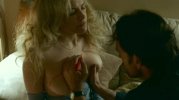I recently watched a Spanish movie called "Coven of Sisters" on Netflix. I thought it was an interesting and worthwhile film in its own right, and worth a watch. There are a few scenes of interest to those of us who appreciate Inquisition movies for reasons beyond their deeply wrought drama and biting social commentary.
It is 1609, and an Inquisitor from the Holy Office arrives at a fishing village in Basque country to rid the people of their pesky witches. Six young women are quickly arrested based on reports that they dance in a wooded glen. They are thrown together into a cell and then are questioned one at a time. The Inquisitor is not only on a witch hunt, but is also obsessed with getting a true account of an actual Witches' Sabbath (called
Akelarre in Basque, the original title of the movie.)
After a couple of the women are tortured (off screen) one of the women, Ana, played by Amaia Aberasturi, realizes that they will all burn whether they confess or not, so to buy time, she convinces the others to give the Inquisitor what he wants. She confesses that she is a witch after a brief stint on the torture table, and tells the Inquisitor that she will not just tell him about the Witches' Sabbath, but show him. They must wait for the full moon, however. This is a ploy, as she knows that all the men will be returning from their fishing expedition on the tides of the full moon, and will presumably settle the Inquisitor's hash when they get back.
In my opinion, a reasonable presumption. I knew some Basques and they were hard dudes. If I were an Inquisitor and was going to torture their women, I would definitely do it while they were away, and I would be long gone before they got back.
View attachment 981323View attachment 981321View attachment 981322 Ana on the table. Her body hair is scraped off with a razor, and her hair is cut to reveal the devil's mark.
View attachment 981320 They can't find the mark by visual inspection, so they resort to the prick.
View attachment 981318View attachment 981319 The interrogator explains that the devil likes to hide his mark in hidden places; inside the nose, in the shameful parts, or even in the eye. At this point Ana confesses.
View attachment 981317Ana is stripped and bathed to get her ready for the Witches' Sabbath. Alas, all we get is the rear view.
I suppose the head covering on the old lady is a provincial style. She makes a joke about it. She tells Ana, I think in Basque so the others won't understand, that everyone knows that the tail of the cap looks like a large cock, but the men are too afraid and embarrassed to say anything about it.
View attachment 981316 On the night before the six women are to burn, they are taken to the glen to perform the Witches' Sabbath. They give quite a memorable performance. One of the women puts her body into some very enticing contortions.
As I said, a worthwhile and interesting movie. Ana's first questioning by the Inquisitor is very effective in revealing just how confusing such an interrogation would be to a relatively simple and naive person. I wonder if it was based on an actual account. Ana more than gets her own back however when she explains to the rapt Inquisitor exactly what the witches get up to during their Sabbath.
I have my usual complaints about the current fad in film making: the reliance on quick cuts and extreme close ups throughout. There is some brief nudity, including the much too short scene with Ana on the table, which is the only torture scene.




